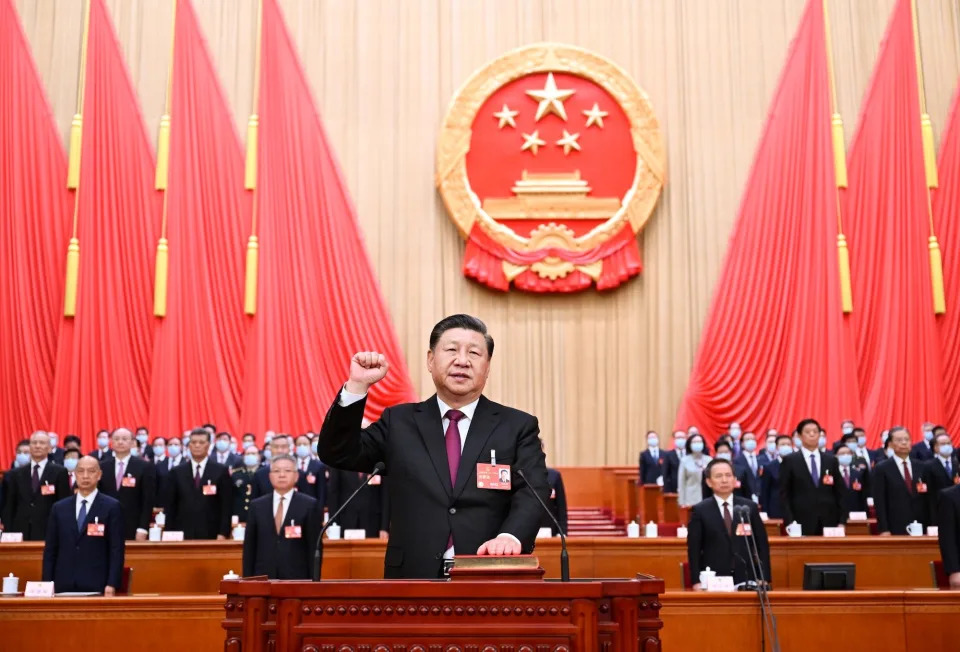Slate
What’s Going On With Brett Kavanaugh?
Mark Joseph Stern – January 23, 2024

On Monday, the Supreme Court affirmed the federal government’s supremacy over the states, a principle established explicitly in the Constitution, enshrined by centuries of precedent, and etched into history by the Civil War. The vote was 5–4. Four dissenting justices would have allowed the state of Texas to nullify laws enacted by Congress, pursuant to its express constitutional authority over immigration, that direct federal law enforcement to intercept migrants crossing the border. These justices would have allowed Texas to edge ever closer to a violent clash between state and federal forces, deploying armed guardsmen and razor wire to block the president from faithfully executing the law.
It was no surprise that three of these dissenters—Justices Clarence Thomas, Samuel Alito, and Neil Gorsuch—sided with Texas, given their overt hostility to the Biden administration’s immigration policies, which verges on rejecting the president’s legitimate right to govern. It was, however, deeply alarming to see who joined them: Brett Kavanaugh, the justice who expends tremendous energy assuring the nation that he is reasonable, moderate, and inclined toward compromise. Kavanaugh’s vote on Monday was none of those things; it was, rather, an endorsement of a state’s rebellion against federal supremacy.
Really, though, should we be shocked that Kavanaugh sided with the Texas rebels over the U.S. president? Maybe not. After spending his first few years on the bench role-playing as a sometimes-centrist, Kavanaugh appears to be veering to the right: His votes over the past several months have been increasingly aligned with Alito and Thomas rather than his previous ally, Chief Justice John Roberts. This shift is still nascent, but it grows more visible with each passing month. And it bodes poorly for the country as we careen toward an election that Donald Trump openly seems to hope the Supreme Court may rig for him.
Start with that jaw-dropping vote on Monday. It’s difficult to overstate how dire the situation had become in Eagle Pass, Texas, where Gov. Greg Abbott mounted his insurgency against the federal government. Migrants frequently cross over at Eagle Pass, so Border Patrol has a major presence in the area. Federal law grants border agents the right to access all land within 25 miles of the border and requires these agents to inspect and detain unauthorized migrants. Yet Abbott defied these statutes: He ordered the Texas National Guard to erect razor wire at the border, a barrier that ensnared migrants (to the point of near death) and excluded Border Patrol. Federal law enforcement was thus physically unable to perform the duties assigned to it by Congress, or to rescue migrants drowning in the Rio Grande. In response, border agents began cutting through the wire, prompting Texas to sue. The far-right U.S. Court of Appeals for the 5th Circuit dutifully issued an injunction prohibiting any federal destruction of the wire fencing.
The 5th Circuit’s injunction effectively allowed Texas to nullify federal law, in direct contradiction of the Constitution’s supremacy clause. Some of the oldest, most entrenched Supreme Court precedents forbid states from interfering with the lawful exercise of federal authority. It should have been easy for SCOTUS to grant the Biden administration’s emergency request by shooting down the 5th Circuit. Instead, the justices spent a baffling 20 days mulling the case—and, presumably, debating it behind the scenes. In the end, all the court could muster was a 5–4 order halting the 5th Circuit’s injunction, with Roberts and Justice Amy Coney Barrett joining the liberals. There were zero written opinions. The dissenters, including Kavanaugh, felt no obligation to explain their votes.
In a sense, Kavanaugh’s silence makes his vote even worse: Having lodged a protest against the single most important principle governing the relationship between the federal government and the states, the justice kept mum, forcing us to guess why he voted in support of nullification. Kavanaugh evidently felt that he owed us no explanation, no reasoning behind his desire to subvert executive authority in favor of a Confederate-flavored conception of state supremacy. His extremism was therefore compounded by an arrogant refusal to justify power with reason, an attitude fit more for a king than a judge.
And not for the first time: Just last month, Kavanaugh cast another silent, startling vote that aligned him with Alito and Thomas. On Dec. 11, the court refused to take up a challenge to Washington state’s ban on LGBTQ+ “conversion therapy” for minors, dodging a case that imperiled similar bans in nearly half the states. Even Gorsuch, Barrett, and Roberts wouldn’t take the bait—perhaps because the case was entirely bogus, cooked up by anti-LGBTQ+ activists despite the absence of a live controversy. But there was Kavanaugh, dissenting from the court’s rejection of the case, telegraphing his hunger to shoot down conversion therapy bans without even the fig leaf of a genuine dispute. Thomas and Alito each wrote angry dissents arguing that the court should’ve taken the case, while Kavanaugh stood alone in his reticence to explain himself. It seems the justice wants to establish a constitutional right to “convert” LGBTQ+ kids, an act that can amount to torture, but lacks the courage to even describe why.
Kavanaugh’s hard-right turn arguably began earlier, in an Aug. 8 order that flew under the radar. It emerged out of a conflict between the Biden administration and gun advocates over a new federal rule that restricts the sale of “ghost guns.” A ghost gun comes in a “kit” that’s almost fully assembled, and a buyer can easily finish putting it together with the help of a YouTube tutorial. Once completed, the gun fires like a semi-automatic firearm. To buy a regular handgun, you have to prove your identity, undergo a background check, and satisfy other federal requirements. To buy a ghost gun, you need only place an anonymous order online. These guns lack a serial number—which are mandatory for regular guns—rendering them untraceable by law enforcement. For this reason, ghost guns are overwhelmingly favored by criminals.
Federal law regulates the sale of “firearms,” the definition of which includes any weapon that “may readily be converted” to shoot a bullet. In 2022 the Biden administration issued a regulation clarifying that ghost guns fit this definition and may therefore be sold only by licensed dealers. This limitation neatly fit the federal statute, which, after all, encompassed partially assembled firearms. Yet, a federal judge halted the rule nationwide, and the 5th Circuit backed him up. The Biden administration sought relief at the Supreme Court, which granted it—by a 5-to-4 vote: Roberts and Barrett joined the liberals, while Kavanaugh joined Thomas, Alito, and Gorsuch in dissent.
Once again, Kavanaugh gave no explanation for his vote. Had he prevailed, the justice would have freed criminals to anonymously purchase untraceable, almost-finished guns online and use them to maim and kill Americans without consequence. Doesn’t such a radical outcome cry out for an explanation? Apparently not to Kavanaugh, who likes to depict himself as a commonsense conciliator on firearms, except when it actually counts.
What’s going on here? One possibility is that Kavanaugh moderated himself during his early years on the bench in the hopes of salvaging his public image after furiously assailing Democrats during his confirmation hearing. After latching himself to the chief justice for half a decade, Kavanaugh may now be showing his true colors, breaking away from the chief’s tactical restraint to chart his own rightward course. Or maybe the justice is being pushed toward the MAGA fringe by contempt for Biden, whose policies he has routinely struck down. Kavanaugh was, after all, a Republican political operative in his past life; it has always been doubtful that he truly slipped his partisan moorings when donning the robe. (Trump’s lawyers put this less subtly, saying that Kavanaugh will soon “step up” for the man who appointed him.)
If partisan discontentment is driving Kavanaugh’s growing alliance with the hard-right bloc, the development has ominous implications for the 2024 election. Already, one major Trump case has hit the court, forcing the justices to decide whether the candidate’s incitement of an insurrection disqualifies him from running for president. Another one is hurtling toward the court, asking whether the Constitution somehow grants Trump absolute immunity from prosecution for his involvement in that insurrection. More election cases will arise as the election draws nearer (presuming Trump is the nominee), many involving access to the ballot. And during the 2020 election, at Trump’s behest, Kavanaugh cast several dubious votes attempting to void valid mail ballots in swing states.
It is encouraging that Barrett has stepped up as an unexpected voice of reason when Kavanaugh defects to the MAGA wing of the court. But Barrett herself is also very conservative, and certainly not a reliable vote for democracy. If a principle as fundamental as federal supremacy can only squeak by on a 5–4 vote, no law is settled and everything is up for grabs. And that, of course, is exactly how Trump wants it.










 Xi Jinping refuses to try the policies that could help pull Chinse out of its national economic malaise.Xie Huanchi/Xinhua via Getty Images
Xi Jinping refuses to try the policies that could help pull Chinse out of its national economic malaise.Xie Huanchi/Xinhua via Getty Images